Additional Slappables: Many players enjoy adding one or more of the following combinations on which a player can legally slap to win the center pile:
- Sequence - The top three or more cards on the center pile could be formed into a valid sequence, either descending or ascending. Around the corner sequences also count for this purpose (i.e. King, Ace, Two).
- Sandwich - A pair of cards with one card of any other value between the pair.
- Double Decker - A matching pair of cards with two of any other card between this pair.
- Marriage - A combination of a King followed immediately by a Queen or a Queen followed by a King.
- Tens - When the last two numerical cards played to the center of the table sum up exactly to Ten. An Ace has a value of 1 for this summation. Any Jacks, Queens or King that might lie in between the last two number cards are ignored.
- Sandwich Tens - When the top two cards add up to ten with one intervening card between.
- Bottoms Up - A card played of the same rank as the first (bottom) card of the pile is played.
- Four in a Suit (Flush) - Four cards consecutively played in turn that are all of the same suit. These four cards need not be in sequential order but must be played in consecutive order.
- Jokers - When this combination is used, two Jokers are added to the deck for play of the game. Any Joker on top of the deck warrants a legal slap of the pile.
Texas Rules: Some players also
play using "Texas rules". When using Texas rules, the goal is not so much to slap first but to grab as many cards as possible. Thus, after slapping the pile, the players then attempt to pull as many cards as possible towards themselves. They may not actually grip or grab the cards but use their slapping hand to attempt to slide as many cards from the center pile as possible to themselves. The cards able to be pulled away in this manner are then added to the bottom of the players own pile. Thus each player, on a slap, may capture the cards they are able to pull away from the center pile.
Invalid Slaps: Another rule that some players use is to change the behavior when someone incorrectly slaps the center pile. In this case, the player who does so must give one card from his stack to each other player in the game who still has cards of their own. They would place this card face-down at the bottom of their current pile
Slapping Variants:
There are also versions of this game with the only difference being in how a player is required to slap the center pile. A few of these are as follows:
- Same Hand Slaps
- This slap variant allows a player to use the same hand in which he plays his card to also be his slapping hand. The same rule for invalid slaps as in the basic game still applies, of course.
- Hand to Forehead
- This version requires a player to first touch their forehead with their slapping hand before they can legally slap the pile. A player failing to do this cannot win the pile, and thus the second fastest slap (if they first made the proper motion) wins the pile instead.
- Safer Slapping
- Some players, in an attempt to avoid or lessen potential injuries during the game, also stipulate specific slapping rules for this purpose. Common rules added for this purpose include; no rings or hand jewelry allowed, open hand only slaps or prohibitions on intentional, delayed slapping when the pile has obviously already been slapped and won.
Three Slaps and Out: In this variation, a player who has no cards is not immediately eliminated if they incorrectly slap the center pile. Only after incorrectly slapping three times (while not having cards) must they drop from the game.
Although Egyptian Rat Slap is often played by adults, the game itself appears to have derived from the combination of several children's games. These include some of the following:
Beggar your Neighbor:
This game appears to be a direct ancestor of Egyptian Rat Slap and often is known by the similar names Egyptian War, Egyptian Rat Killer,
or Beat Your Neighbor. It is best when played by two but can be played by as many as 8.
After selecting the dealer and seating positions, the dealer should deal out the entire deck in a clockwise direction, one card at a time. Some players may get one extra card if the cards can not deal out evenly, which is acceptable.
The players arrange their dealt cards face down in front of themselves and may not look at the values of the cards in their stack. Beginning with the player to the dealer's immediate left, the players take turns by adding one card face up from their stack to a center pile.
If a player plays any numerical card (2-9) to the center the turn passes to the next player who then lays a card of their own. However, if a player plays any letter card (Ace, King, Queen or Jack) to the center, the next player must play a number of cards to the center dependent on the specific letter card played. After the opponent plays the required number of cards, the player who played the letter card then takes the entire pile and places it face down under his own pile. However, if while playing the requisite number of cards, he plays a letter card of his own, the next player in turn must then play a set number of cards to the center. This can continue until a letter card is not played, at which time the player who played the last letter card takes the entire center pile. This captured pile is always placed face down under that player's current pile. The number of cards a player must play is dependent on the specific letter card played as per the following chart:
| Letter Card Played | Number of Cards Required |
|---|
| Jack | 1 |
| Queen | 2 |
| King | 3 |
| Ace | 4 |
|
|
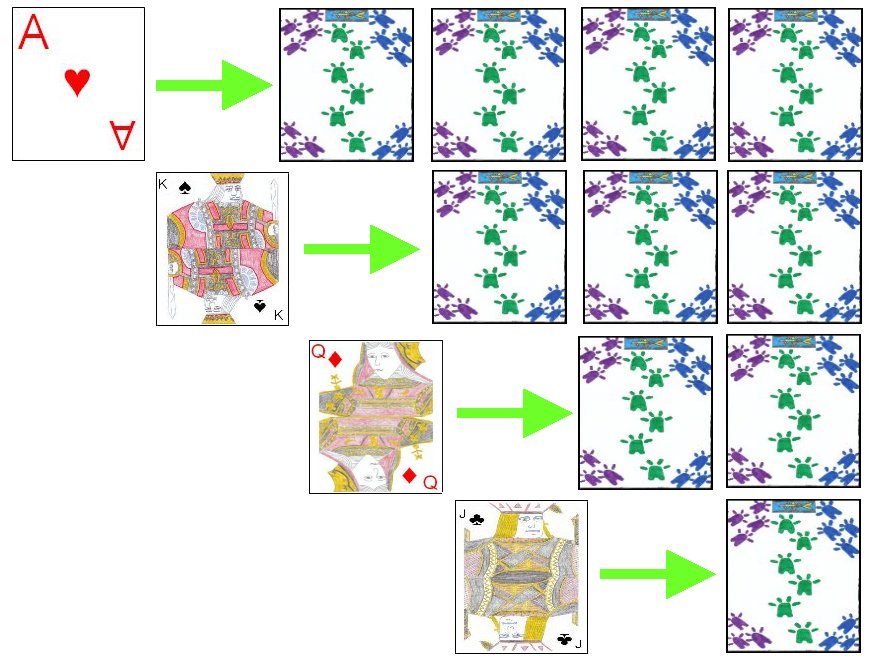 |
When a player runs out of cards he must drop from the game. Play continues until there is just one player remaining with any cards, who is the winner of the game.
Camicia: Camicia is a Sicilian children's card game which is played very similarly to Beggar My Neighbor. Camicia is
traditionally played using the 40 card Italian deck and is usually played by two participants. The Italian deck consists of four suits with eight cards in each suit. These cards are in the denominations; Ace, 2, 3, 4, 5, 6, 7, Cavalier (Jack), Queen, King.
Determination of the first dealer and seating positions can be performed using any of the standard methods, such as draw for high cards. Once the players are seated and the first dealer determined, the dealer should distribute the entire deck (20 cards to each player), with each player having his cards in a face-down pile of cards.
Play then begins with the opponent of the dealer and play alternates amongst the two players. A turn consists of a player turning up the current top card of his pile of cards. If this card is any card except for an Ace, 2, or 3, he should place this card in a face-up pile near the center of the pile. However, if this card is an Ace, 2, or three, that player's opponent is required to play a number of cards to the table from his pile, based on the card so exposed:
- An Ace requires the opponent to play exactly one card.
- A two requires the opponents to play exactly two cards.
- A three requires the opponent to play three cards.
When a player is so required to make a play of so many cards, he thus draws these cards one by one from the top of his stack. If all such cards thus played by the opponent are normal cards (not a 2, 3, or Ace), the opponent then takes the played cards and all the other cards from the center pile and adds it face-down under his current play pile.
However, if any of the cards played from the pile is also an Ace, 2, or 3, the obligation is immediately reversed and then the other player is then expected to play a number of cards based on the card so drawn. Once the cards all played by an obligated player are normal cards (no Aces, twos or threes), that player's opponent may then add all cards currently found in the center pile to the bottom of his pile.
The game continues in this way until a player runs out of cards, with his opponent then declared the game winner.
SlapJack: Slap Jack is a perennial favorite among children everywhere. This game can be hard on the cards used, so it is preferable not to use your best deck when playing. Slap Jack, also called Slaps can be played by almost any number of participants. After the dealer is determined the entire deck should be dealt out as evenly as possible. The dealt cards are arranged by each player in front of themselves in a neat face-down stack but they should not view the faces of the cards. Any extra cards that could not be evenly dealt should be placed face-up in the center of the table to start the center pile. The player to the left of the dealer takes the first turn.
A players turn consists of a player taking the top card of his stack and placing it face up in the center of the table. If this card is any Jack, the first player who manages to slap the card captures the entire stack. He gathers the center pile, shuffles it and places it face down under his current stack. When slapping, a player must use the same hand used to play cards to the center of the table. If another card (non-Jack) is played before anyone slaps, the slap is considered an invalid slap and no one wins the pile until the next Jack is revealed. Slapping a card not a Jack normally does not incur any specific penalty, although specific variant rules are sometimes added.
If a player runs out of cards they may still remain in the game until the next Jack is played. If they are unable to capture the pile at that time, they must drop from the game. The game continues until only one player remains with cards, who is declared the winner.
Being a very popular children's game, it is not surprising many variations of basic Slap Jack have been developed. These include the following modified rules:
- Slap Penalties - In the standard game there is no gameplay penalty for incorrectly slapping when the top card of the center pile is not a Jack. However, when using this variation, if a player incorrectly slaps when the card is not a Jack, they must give one card from their pile to each other active player who still retains cards. If a player improperly slaps who has no cards, they must drop from the game.
- Hand to Forehead First - Similar to the variant of Egyptian Rat Slap, before any player may make a valid slap on a Jack he must first touch his forehead with his slapping hand. If a player forgets to do this before slapping a Jack, his slap cannot win the pile, even if his is the lowest hand in the pile.
- Similar to the previous variant, another fun variant used is "King Salute". In this variant, Kings are slapped instead of Jacks. When a King is exposed the players must first salute and then slap the card. If a player slaps the pile without first making the appropriate salute gesture, this is not considered a valid slap and he is not entitled to win the pile.
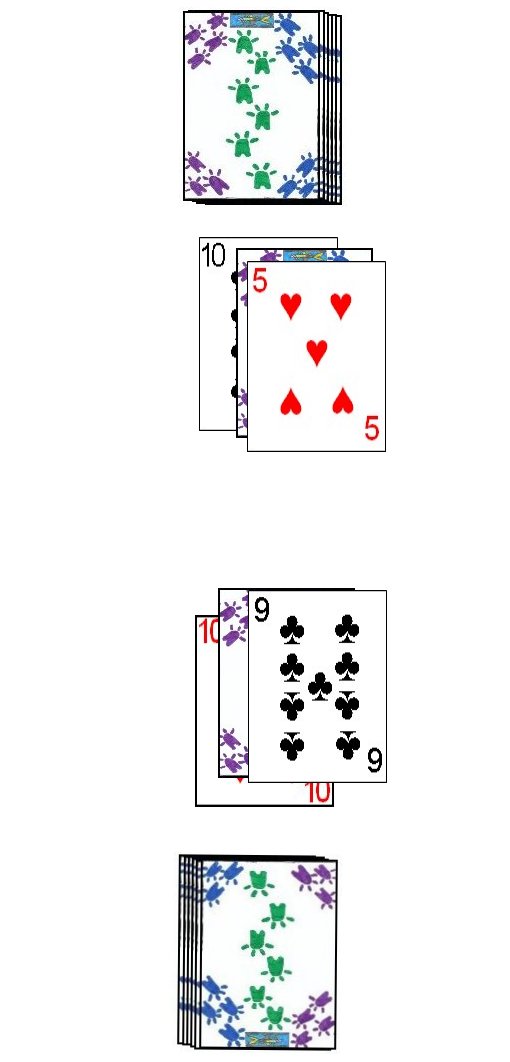 War
War: War is the classic children's game that along with Go Fish are probably the most widely known
and played card games in the world. War is designed to be played by two players using one standard 52 card deck. The ranking of the cards in the deck is as follows from High to low; King, Queen, Jack, 10, 9, 8, 7, 6, 5, 4, 3, 2, Ace.
One of the players then divides out the deck in half, each player receiving a stack of 26 face down cards in a neat pile, which is his play pile. Each turn consists of both players flipping over the top card of their stack and placing it in front of their play pile. Whichever card is of a higher denomination takes both cards and places them face down on the bottom of his own play pile. If both cards are of equal rank (such as two tens) this is called Going to War. When this does occur, the players then each place the next face down card from his play pile on top of their previous card and then another face up card on top of the face down card. The higher of these two cards then takes all six cards. If the new faced cards are again of matching rank, another face down card and face up card is played by both players. This continues until one of the player cards is a higher ranked cards who then captures all such played cards, taking them and placing them face down under his play pile. The game continues in this manner until one player captures all of his opponents cards, after which time he is declared the winner of the game.
Being such a widely known and played games, it is not surprising that there are a large number of variations of this game. Some of the more popular such variations follow:
- Three Card Wars:
In this variant, instead of one face down card being played by each player in the event of tied face up cards, both players would play three face down cards before turning the next one face up. As in the original game, continued matching ranked cards would continue this until there one player plays a higher card.
- Quadruple War:
In the variant titled Quadruple War, each player would place four face down cards in the event of a war and then one face-up card. Whichever of these new face-up cards was higher would win all these cards. In the event of another tie, four more face down cards would be added and another face down, continuing until one of the two faced up cards is a winner.
- Variable Card Wars:
In this variant, the rank of the matched cards determines the number of face down the players must play before adding the next face up card. An Ace requires the play of one face down card, a King 13, Queens 12, Jacks 11, and all other cards the numerical value marked on the card. If the second face up card by both players is also of equal rank, the players again add a number of face down cards based on the specific denomination of the new cards matched.
- Progressive War:
In this variant, when the two faced cards are matched, each player adds one face down card and then one face up. If these cards are also matched, each player then places two face down cards and one face up. If these next face up cards are again matched, the players then add four face down cards and one face up. Each additional set of tied cards, until a clear higher card is exposed doubles the number of face down cards the players must add (to a maximum of 16, with additional matches requiring 16 cards each time).
- Ace High:
In some variants the Ace is considered the highest card (ranking above the King) instead of the lowest card in the deck.
- Crazy Jokers:
In this variant, two Jokers are added to the deck used for the game. Normally, a Joker is considered the lowest card in the deck losing to any other cards. However, if the opponents card is the highest ranked card (King) the Joker wins, allowing capture of the card. If both players expose a Joker, a war occurs as normal.
- More Players:
Although originally designed for only two players, this game can also be fun for up eight. For even more players a double deck can be used. To start, the cards should be dealt as far as they can be equally distributed. Any cards that cannot be distributed are placed face down to the side, to be won by the player to win the first War. As in the normal version, all players place a card face up to the center of the table, with the highest card taking all these cards played and adding them face down under his own play pile. However, if there are two or more matched cards, the players who originally played those matching cards must then go to War. All other players (including any who potentially played a higher but unmatched card) cannot win these cards and must wait until they are won by one of the players who originally played one of the equally ranked cards. They thus place one face down card to the center of the table, and then take the next card placing it face up. The highest of these new cards then takes all cards played, unless there is again a tie between two or more cards. In that case, the players with those two tying cards do the same thing, continuing until there is just one card which can be designated as the highest ranked. When a player runs out of cards he must immediately drop from the game, with the game continuing until only one player has cards remaining, whom is declared the winner.
- Ibigurasha:
Ibigurasha is a variant of War (or "Battle") as played in the African nation of Rwanda. This variant is played by two players and uses an abbreviated deck consisting of only 18 cards. This deck consists of four each of cards in the denominations 2, 8, 9, 10's and two Jokers. The ranking of these cards in this deck is as follows (from highest to lowest): 2, 8, 9, 10, Joker. Gameplay as is in most other variants of the game, with each player randomly receiving half of the deck in a face-down pile. Each player then plays the top card from their pile, face-up to the table. The higher card of the two wins the battle, and the winner of those two cards places them face-down at the bottom of his pile of cards. If the cards are of the same denomination, each player adds the next card from their pile face-down on the stack, and then plays the next card face-up. The higher of these two cards then wins all the cards on the table adding them all, face-down to the bottom of his pile. If these are again tied, the same procedure is repeated. The winner is the player to obtain all 18 cards. However, if there is a tie of equal cards being played, and one player does not have enough remaining cards to supply the needed two additional cards, the game is considered a tie, and a new game is played.
Bidding War:
Bidding War is a fun variant of the classic children's game War. This
variant is played similarly to the standard two player version of War
with the exception that the player's are given some latitude in decisions made during play.
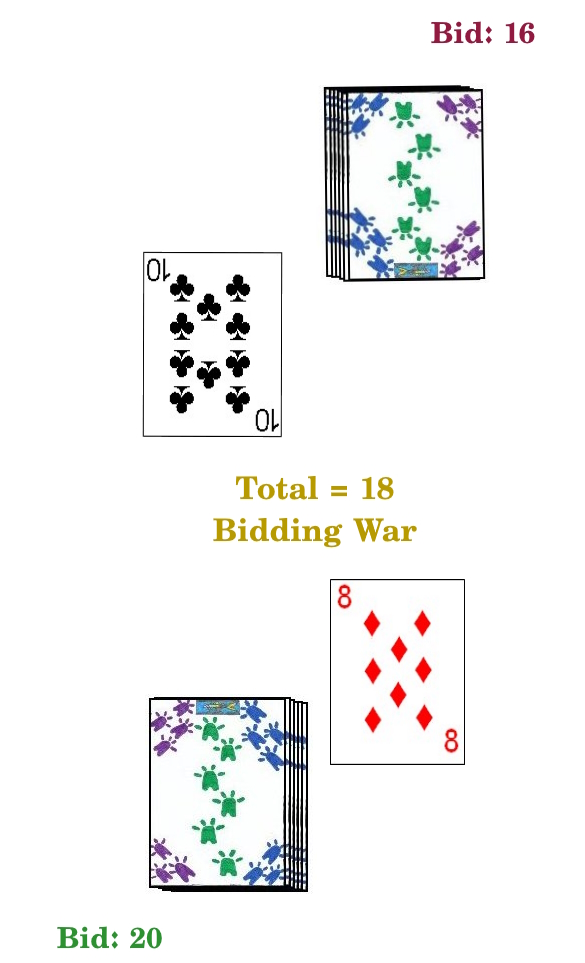
This version uses one standard deck with the same ranking as the standard game. However in this variant, each card is also provided a specific equivalent numeric value. The following chart shows the values of the cards in the deck used for this game:
| Card | Numeric Equivalent Value |
|---|
| Ace | 1 |
| 2 to 10 | Value marked on card |
| Jack, Queen, King | 10 |
The shuffle and deal are the same as used in the standard game with each
player receiving 26 cards in a face down pile which they are not
permitted to look at.
To begin, the non-dealer guesses a total in which believes that the cards turned up from each player's pile will total to. After the first player makes a guess the second player then makes his own guess. His guess may not be the same as the first player's guess and must in fact be a total of two higher or lower than the previous player's guess. After both players make their guesses, each player then exposes the top card of their pile.
If one of the player's correctly guessed the sum of the two cards, he takes both cards adding them face down to the bottom of his own pile. In addition, his opponent must give him the next two top cards from his own pile which are placed on the bottom of the opponents pile. If neither player guessed the correct sum but one player is closer to that sum, that player takes both cards and adds them face down to his own pile. However, if the difference between each players guess and the correct total is the same, a Bidding War ensues.
In the event of a Bidding War, each player may look at the next top card of his own pile. The player who made the first bid during this turn then makes a guess of the sum total of the two cards. His opponent then has the option to either bid a higher sum (at least one higher) or "call". If he makes a higher bid, the original player may then make a still higher bid or also call. This continues until one player calls, after which the top card of each players pile is exposed. If the sum of both cards is higher than the high bid, the high bidder takes all cards exposed on the table during the war as well as the next face down card from his opponent's pile. However, if the bid was lower than the high bid, the calling player wins all cards exposed during the bidding war as well as one card from his opponent's pile.
After each turn, the player who did not win any cards on that turn makes the first guess on the next turn. The game continues until one player has won all the cards in the deck, after which he is declared the winner of the game.
Pisha Pasha: Pisha Pasha is another game played similarly to War. It should not be confused with the game Pishe Pashe which is a form of multi-player Canfield (which is described at
this link).
Pisha Pasha uses one standard deck of cards and is designed to be played by two players. The ranking of the cards is identical to that in standard War. Determination of the first dealer and seating is also done in the same way as standard War, usually consisting of both players drawing a card from the shuffled deck and the player drawing the higher card becoming the first dealer.
Once the first dealer has been determined, he thoroughly shuffles the deck and offers it to his opponent to cut. After the cut, the dealer deals out the entire deck, one card at a time and face-down. Each player should thus receive 26 cards. Each player should form his cards into a face-down pile.
Each play thus consists of both players taking the top card of his stack and placing it face-up on the table. If both cards played are not of the same suit, the players again take the top card of their stack playing it to the center of the table. This continues until the card played by each player is of the same suit. When this occurs, the player who played the higher of those two cards wins the battle, capturing all the cards currently played to the center of the table. He forms all the captured cards into a face-down stack and places that stack under his current pile.
The game continues in this manner until a player runs out of cards, with his opponent then declared the winner of the game. In the rare case in which both players run out of cards on the same play (and the suits of those last cards played are not the same), the game ends in a tie.
Snap Slap:
This is another game similar to SlapJack. Often called simply Snap, which is also the name for a different game described below.
Snap Slap is played identically to Slapjack with the only difference being in the conditions in which a player may slap the center pile. At any time the top two cards of the center pile are a matching pair, the pile is liable to be slapped. The first player to slap the pile wins the center pile. He does not shuffle pile, but turns it over and adds it beneath his current pile.
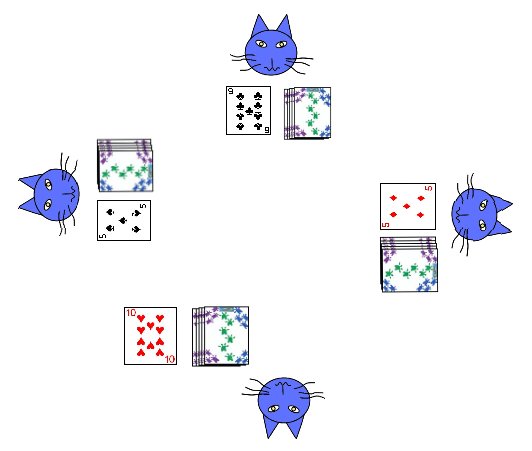 Snap
Snap:
Snap is another card game often played by children. Designed for from 2 to 4 players, the goal is to capture all of the cards. Once the seating positions and first dealer are determined, the dealer shuffles the cards and deals out the entire pack face down one at a time around the table. One or more players may receive an extra card but this is common and acceptable in this game. The players do not actually look at their cards but keep them all in a neat pile face up in front of themselves. The player to the dealer's immediate left has the first turn.
On his turn, a player takes the top card of his face down pile and turns it face up next to his face down pile. When turning the card he must do so in such a way that the card is turned away from himself so he does not see the card before any other player does. On subsequent turns, he adds a card from him hand to this pile. The turns continue in a clockwise rotation around the table, with each player turning over his top card and placing it in a pile next to his face down pile.
At any time that the turned over card numerically matches the top card of any other player's pile, the first player to loudly shout "Snap" wins both piles, placing them both face down on the bottom of his current face down pile. After the pile is captured, the turn continues with the next player after the last who turned a card. If two or more players shout "Snap" at the exact same time, no one wins the piles and both piles are placed in a stack face up to the center of the table, one on top of the other. If there are already cards in the center from previous unwon ties, the new cards are placed on top of the existing cards. If a card is exposed of the same number as the top card of the center pile, the first player to shout "Snap Pot" wins the center pile and any other piles topped by the matching card. He places all cards captured face down under his current face down pile. If this call is also tied, both piles are added to the top of the center pile.
If a player incorrectly shouts "Snap" or "Snap Pot" (when there are not two cards of the same denomination exposed) he must give one card from the top of his own pile to each other player. These cards are added to the bottom of the player's current face down pile.
If a player runs out of cards, they turn their face up stack face down, with this becoming his new play pile. If a player has no cards in either pile, they must drop from the game. The last player with cards is declared the winner.
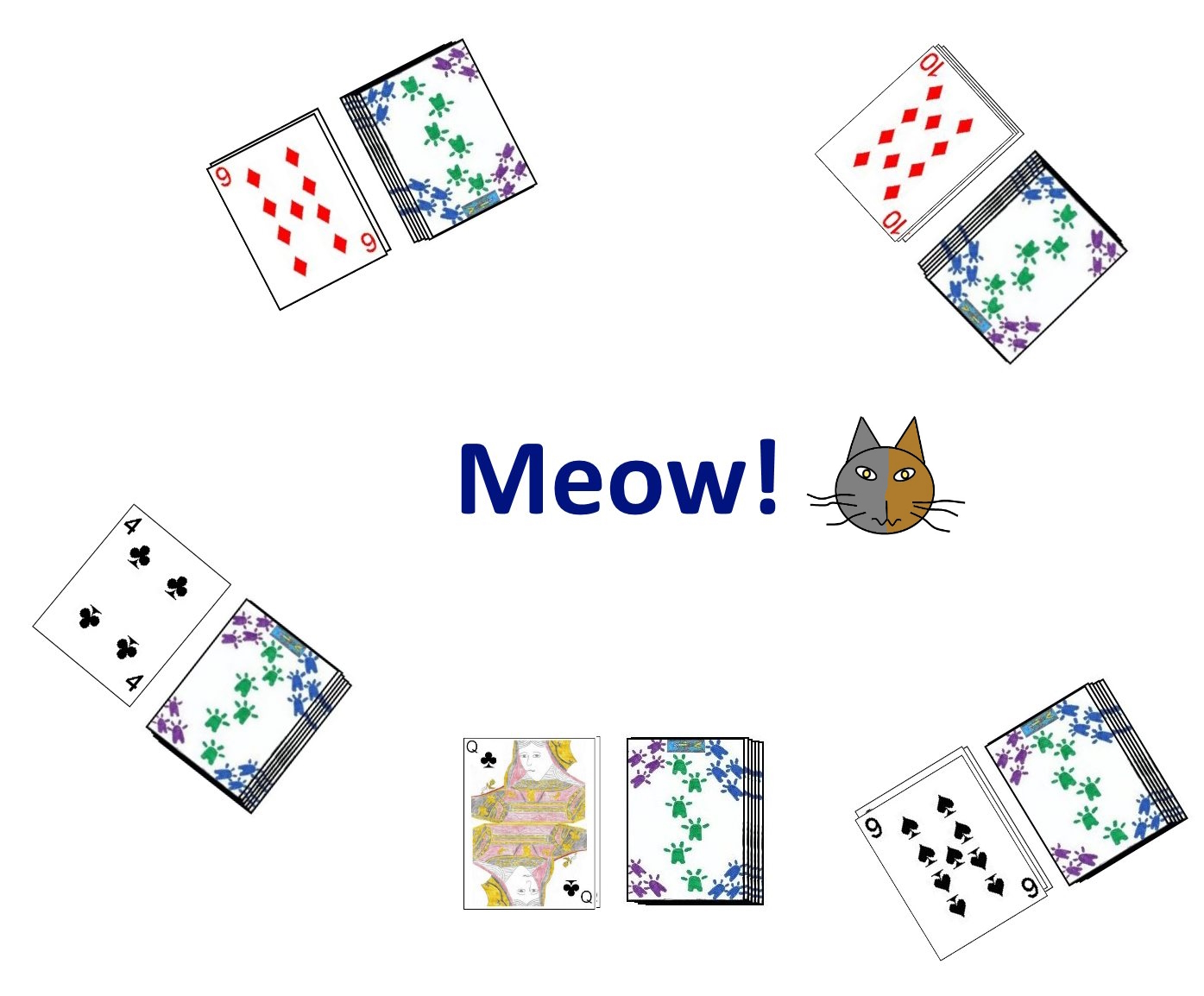 Animal Snap
Animal Snap:
Animal Snap is another variant of snap which is a favorite of children everywhere and is designed for 2 to 4 players. It is played similarly to standard Snap with an entertaining twist. Animal Snap uses one standard 52 card deck.
Before start of the game each player selects a specific animal stating the animal and demonstrating the sound it makes to all the other players (such as a duck, dog, elephant, monkey or cat). The oldest participant in the game is usually set as the first dealer, who then deals out the entire deck to the players, one by one in a clockwise rotation. Some players may receive one extra card than others but this does not matter and should not effect gameplay.
After all the cards have been dealt, each player should square up his cards in a face down stack in front of himself. Players do not look at their cards. The player to the immediate left of the dealer has the first turn.
Each player, on his turn, takes the top card of his face down stack and quickly places the card face up next to his face down stack. The next player in a clockwise rotation then does the same thing. This continues around the table with the players continuing to expose cards from their face down stack to their own face up stock. If a player's newly exposed card matches the face up card on any other players face up pile, the players attempt to mimic the animal sound chosen by the player with that other players card. The first player to make the sound is entitled to take both piles with the matching cards and add them face down to his own current face down stack. However, if the player makes the incorrect animal sound they must give their own stack to the player who played the matching card. If a player makes an animal sound when there are no matching cards, he must give one face down card to each other player to add to the bottom of their own face down pile. If two players manage to make the correct animal sound at the exact same time, the two piles containing the matching cards are placed face down in the center of the table as a pool. These cards are then won by the next player to win any cards. If a player runs out of face down cards he then takes his face down stack (if he has one) and turns it over to start a new face down stack. If he has no cards in his face down stack, he must drop from the game. The game continues until one player has captured all cards in the deck.
Mana Nerviosa:
Mana Nerviosa is a Peruvian counting type card game with similarities to Egyptian Rat Slap. While often played by children it can also make for a fun and light-hearted game for players of any age. Mana Nerviosa can also be used to teach basic counting to some of the youngest players. This game is also played in Ecuador, by the name Burro Nervioso.
This game can be played by any number of players from 2 to 6, but is usually best for 4 to 6. The game uses two standard 52 card decks shuffled together to make one larger deck. Determination of first dealer and seating positions can be performed in the same manner as in Egyptian Rat Slap. Once this is determined the designated dealer should begin dealing the cards one face down card at a time starting with the player to his immediate left. He continues dealing the cards in this way in a clockwise rotation until the entire deck has been dealt. Some players may receive an extra card but this is ok. Each player should arrant his cards into a pile in
front of himself. However, the players should never look at the cards they have been dealt.
Once the entire deck has been distributed, play begins. Play consists of a player taking the top card from his dealt pile and flipping it face up to the center of the table. Simultaneously, he would say Uno (or one). The next player in a clockwise rotation would then take a card from his own pile, flipping it on top of the last card played and say dos (or two). This continues from player to player around the table with each player playing a face up card and announcing the next number in sequence (in English or Spanish) until a player reaches the count of trece (thirteen). After reaching this count, the next player in turn would begin again with uno. If at any time, the stated number matches the played card (as per the following chart), the players are entitled to attempt to slap the card. The first player to manage to do so wins the entire pile, gathering the pile together, turning it over and placing it face down under his current stack. The following shows the card equivalent for each marked card in the deck:
| Value Marked on Card | Equivalent Count |
|---|
| Ace | One or Uno |
| 2 to 10 | Value as marked on card - Two to Ten (Dos to Diez) |
| Jack | Eleven or Once |
| Queen | Twelve or Doce |
| King | Thirteen or Trece |
|
|
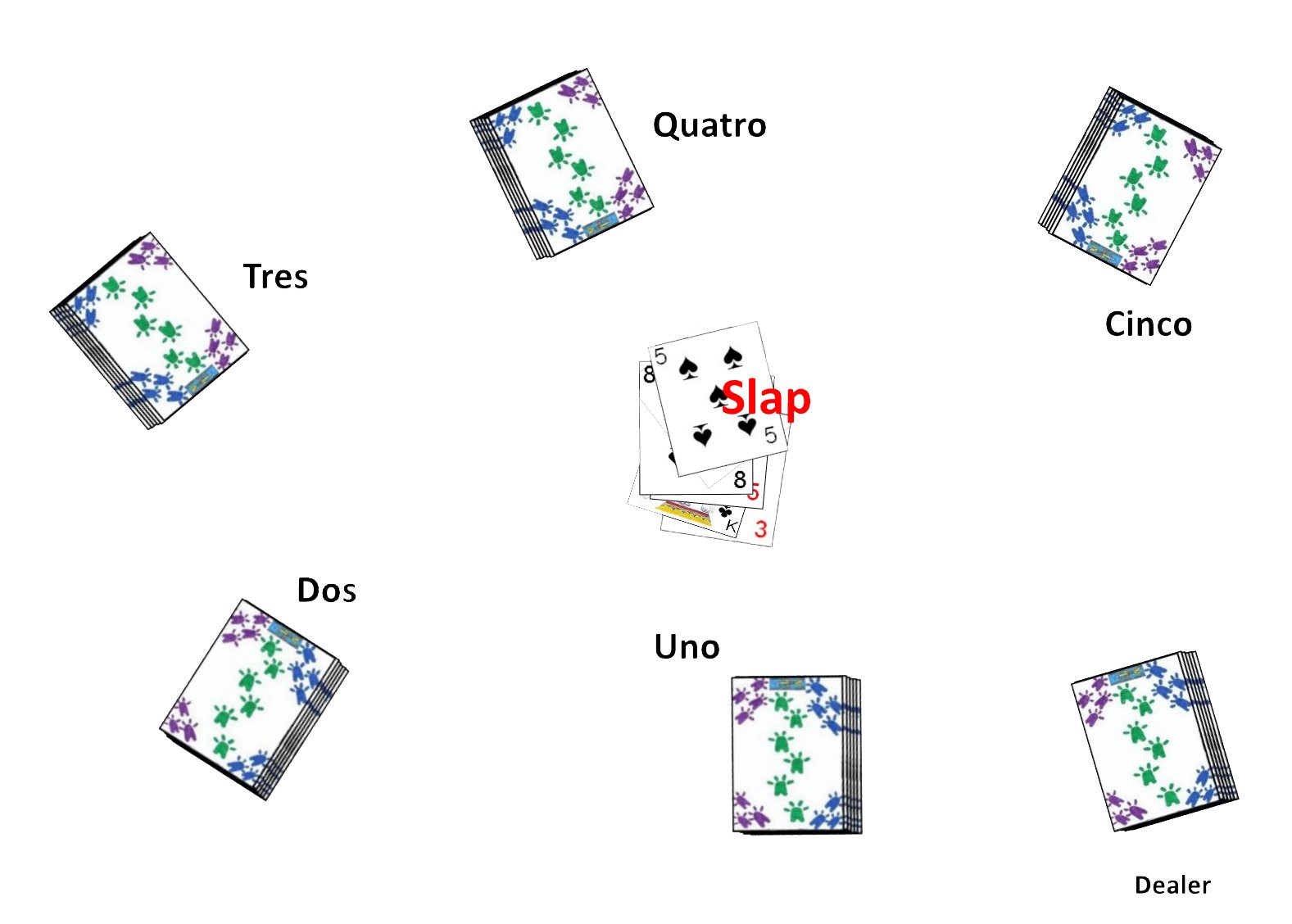 |
If a player incorrectly slaps the pile when the stated number does not coincide with the card actually flipped, that player must take the top 10 cards from his pile and add them to the bottom of the center pile. If they have less than 10 cards remaining, the player places all his remaining cards at the bottom of the center pile.
When a player plays runs out of cards he no longer takes his normal turn, but remains in play and may still slap an appropriate card. If a player manages to earn more cards by correctly slapping the pile, he then resumes playing a card on his proper turn. The game continues until one player has won all the cards.
Siete Pega Todo: While Egyptian Rat Slap and some of the other related games described on this page feature slapping,
in the game Siete Pega Todo, hand slapping is the ultimate goal of the game. Siete Pega Todo (Seven Slaps All) is an Ecuadorian game for play by 3 to 8 players. The game is played using one standard 52 card deck. It can be a very silly game.
The dealer of each hand can be determined using any manner of method, such as draw of cards from the deck. After each hand, the role of dealer rotates in a counter-clockwise direction around the table.
The game consists of the dealer thus, starting with the player at his immediate right, dealing a face-up card from the top of the deck to that player, with the specific denomination of this card indicating a specific action this player will take, almost always involving slapping another players hand. After the player takes the action the card is then discarded, out of play. The game continues with the dealer dealing a card to each player in a counter-clockwise direction around the table until the deck has been exhausted. The specific action taken by the player is directly dependent on the rank of card dealt to that player. The specific range of actions can vary widely amongst groups of players, but the following is one such collection of actions that might be used:
- Two - A Vos - The player dealt a two must slap one of their hands with their other hand one time.
- Three - Al Juez - The player dealt the card slaps the dealer's hand one time.
- Four - Al Mas Gato - The player dealt the card slaps the hand of the player with the lightest colored eyes.
- Five - Al Brinco - The player dealt the card slaps the hand of the player that is two players to his right.
- Six - Al Que Veis - The player dealt the card slaps the hand of the player who first makes eye contact with the player dealt that card.
- Seven - Siete Pega Todo - From the name of the game, the player dealt a seven slaps the hand of each other player one time.
- Eight - Al Tocho - A player dealt this card slaps the hand of the shortest
height player in the game.
- Nine - Al Que Se Mueva - The player dealt card of rank nine slaps the
hand of the next person to make any movement, including speech (moving the
mouth) or moving their eyes.
- Ten - Hidden - A player dealt a 10 does not immediately take any action, but retains this card until the end of the hand.
- Jack - A La Izquierda - A player dealt a Jack, slaps the hand of the player immediate at his left.
- Queen - A La Derecha - Being dealt a Queen, the player slaps the hand of the player at his immediate right.
- King - Al Frente - A player dealt a King slaps the hand of the player directly across the table from themselves.
- Ace - Venganza - A player dealt an Ace takes no immediate action but retains the card until the end of the hand.
After all the cards have been dealt out, for each ten a player was dealt, he may slap the hand of a player of his choosing. However, if a player is intended to be the recipient of such a slap, if he has an Ace, he may play that Ace to avoid that slap.
After all the tens have been played, as appropriate, whichever player has the reddest hand (i.e. from having received the most slaps during the hand) receives seven additional slaps on the hand from each other player.
Irish Snap:
Although deriving from a conglomeration of various children's games, Irish Snap, like Egyptian Rat Slap is often played as a fun party game by groups of adults (best with 3 to 8 players). The game has some similarities to Egyptian Rat Slap, however the goal in this game is reversed, the players vie to get rid of their cards as fast as possible.
This game is played using one standard 52 card deck. Determination of seating positions and first dealer can be done using any mutually agreed upon method, with drawing for low card being common. Once this is determined, the dealer first shuffles the cards and then deals the entire pack, face down around the table one at a time. If one or more players receive an extra card this is acceptable and happens when the cards cannot be divided evenly amongst the number of players participating.
The player to the dealer's immediate left has the first turn with the turn continuing in a clockwise rotation around the table. On his turn, a player turns over the top card of his stack and places it in the center of the table. When doing so, he must turn the card outward away from himself such that he does not view the face of the card before any other players. In so doing, he also attempts to make this motion as fast as possible so the other players do not see the card too much sooner then himself.
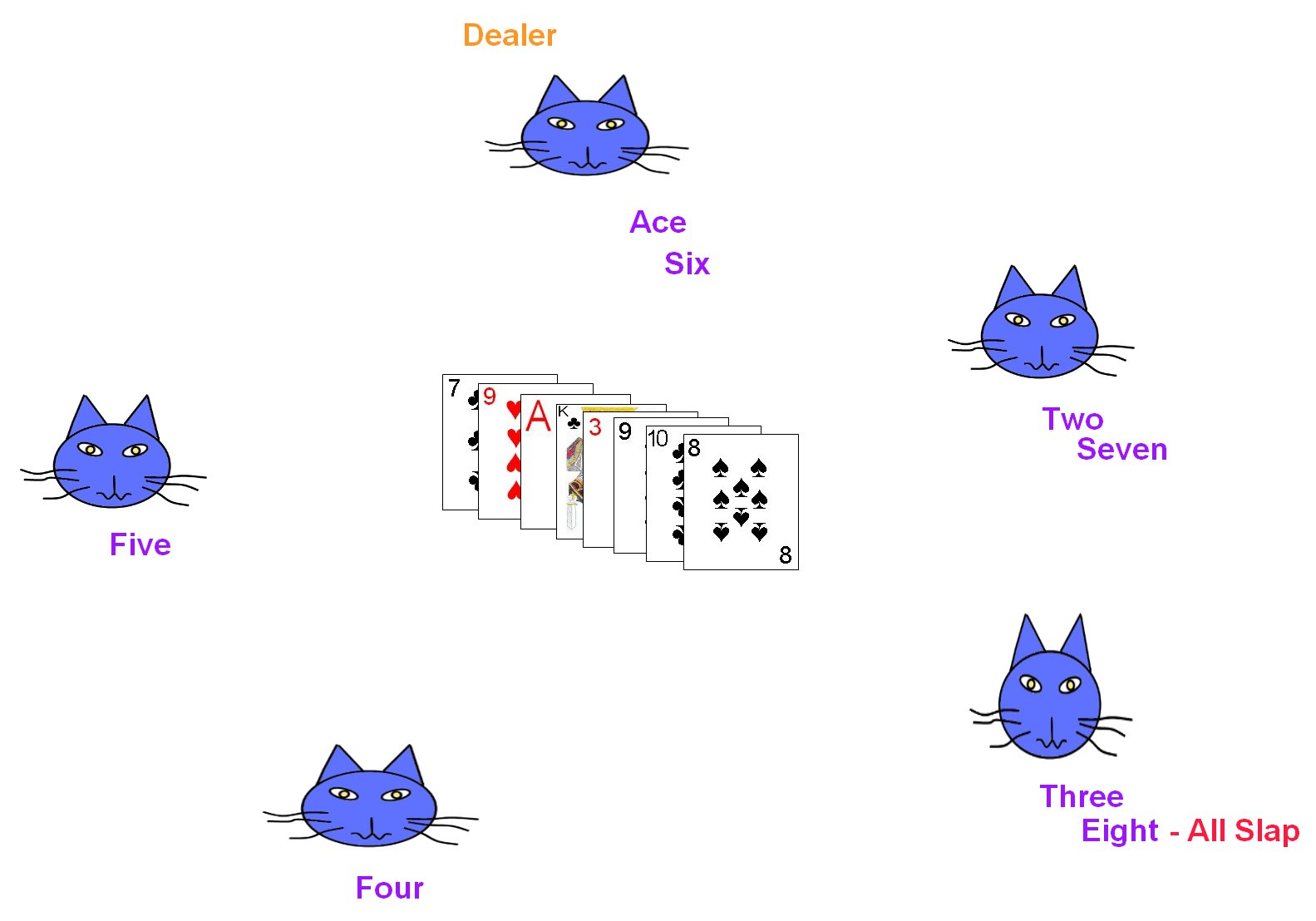
As each player plays his card on his turn he must clearly state the next card in an ascending series, starting with Ace. Thus, the normal sequence is as follows: Ace, Two, Three, Four, Five, Six, Seven, Eight, Nine, Ten, Jack, Queen, King. The player after the player stating "King" would then start again with Ace, cycling through the series continuously until a valid slappable combination appears. Thus, the first player would state "Ace", the second player "Two", the third player "Three" and so on.
If at any point the card turned over to the center by the current player actually matches the denomination which is verbally stated by the player, all the participants attempt to slap the center pile. The last player to slap the pile must take the entire center pile, sliding it under his own current pile, face down. In addition, if the top two cards of the center pile are of the same denomination, the players must also slap the pile, with the last player doing so required to take the entire center pile. The player who takes the stack then starts the next sequence of cards to the center, beginning again, stating "Ace" as he plays his card. If a player attempts to slap the pile (even if they don't actually contact the top of the pile with their hand) when a slap is not warranted must then take the entire pile. This false slap is called flinching.
As players run out of cards, they no longer continue play. The game continues until only one player retains cards, with this player having lost the game.
An optional rule sometimes added to this game is the silent count. In this version a running count is still performed, however the players do not actually state aloud the current rank. Thus, the players must keep the count silently to themselves, and are still required to slap when the upcard matches the current rank in the ongoing sequence.
Extreme Irish Snap:
This version of Irish Snap is played identically to standard Irish Snap but includes a number of additional rules which can make the game even more fast moving and challenging. These include the following:
- Kings - When a King is played the players must also slap, regardless of the stated rank. However, before slapping, the players must first touch their forehead in a salute with the slapping hand. Failure to first make the saluting motion nullifies that players slap who must then slap again after making the appropriate motion.
- Sevens - When any seven is played the players no longer state aloud the current rank in the sequence. This continues until another seven is played. However, a running count is still required, so the players must still retain the count silently to themselves. When the card exposed matches the current, valid running count the players must still slap the pile.
- Running out of Cards - When a player runs out of cards he still remains in the game. On his turn he must still state the next rank in sequence but obviously does not play a card. If the top card of the stack matches his statement, the pile must still be slapped. In fact, the pile can be slapped before he makes his statement as long as the top card is the same as the rank he would normally be required to state. If the player having no cards is the last to slap, he would still be required to take the center pile. As in standard Irish Snap, the game continues until all players but one have run out of cards.
- Queens - When a Queen is played, the players must all slap the pile.
In addition, many games include the addition of one or more of the following rules when playing Extreme Irish Snap:
- Slap Avoidance - When a Queen, King or pair is on the table and also matches the current stated rank, players must NOT slap. If any players slap, the first player to do so must take the entire pile.
- Add Your Own Rule - This optional rule states that if the same player manages to be the first valid slapper on two consecutive slapping opportunities, that player may then add a new rule to the current game. He must clearly state the rule for all players to hear.
- Jacks Reverse - If a Jack is played, the current direction of play is reversed. Players would only slap the Jack if "Jack" was the current stated rank.
- Snap Runs - If a run of three consecutive ascending or descending cards are played in sequence the players must slap the pile.
As in standard Irish Snap, the last player who has cards remaining is said to have lost the game.
Bishop's Rear: Bishop's Rear is a social game which is popular in Poland, usually with
children but also adults. It goes by a number of less family friendly names, but whatever name it is played by the rules are the same.
The game can be played by from 2 to 10 (or even more) players. A number of cards should be removed from the deck in order to ensure all players receive the same number of cards (for instance, in a five player game 2 cards would be removed such that each player would receive 10 cards in the deal). The cards removed from the deck should not include any Kings, Queens, tens or Aces. The ranking of the cards as well as the specific suits are
irrelevant in this game.
After the player's are seated the designated dealer should thoroughly shuffle the cards and begin dealing the cards, one by one and face down in a clockwise rotation around the table starting with the player to his immediate left. He continues dealing in this way until he has dealt out the entire deck.
After the complete deck has been fully dealt, each player then neatly arrange his face-down pile of cards in front of himself without looking at any of the cards in his pile, after which play begins.
The hand begins with the player to the dealer's immediate left and consists of a player taking the top card from his pile and placing it in the center of the pile. Play continues in this manner, with each player in a clockwise rotation adding the top card from his pile face-up to the center of the table, until certain, specific cards are played. When these special cards are played, they require certain actions or phrases by all participants in the game, as follows:
- If any King is played, all players must immediately make a saluting
motion with his right hand. Alternately, players may loudly state "Good morning, Sir".
- If a Queen is played, all players must loudly state "Good morning, Ma'am".
- If an Ace is played, all players must loudly state "Bishop's Rear".
- If any ten is played to the center, all players must attempt to slap this card.
If any player fails to make the required motion or phrase, makes the incorrect motion or phrase or
unduly hesitates in taking the required action, that player must take all the cards currently in the center of the pile, turn them over and add them to the bottom of his own pile. If multiple players make the wrong action, they must divide these cards amongst them, as evenly as possible. In the event a 10 is played, the last player to slap the pile must take the entire pile into his own pile.
The first player to deplete all of his cards is declared the winner of the game. Many players enjoy the optional rule that the winner of each round is entitled to specify the special action for another card type in the deck. He may not change the action for an existing card denomination unless there are no denominations that currently do not have an action associated to them, upon which he may reassign a new action to a pre-existing card.
Buona Sera Signorina: Buona Sera Signorina is a silly and
hilarious Sicilian game. The game is best played by 2 to 8 players and usually uses a 40 card Italian suited deck. This Italian deck is comprised of 40 cards in four suits, with one card in each suit of the following denominations; Ace, 2, 3, 4, 5, 6, 7, Cavalier (Jack), Queen, King. The players should each be seated at the table such that they can reach a central play pile near the middle of the table. The entire deck is dealt out to the players and each player should keep his cards in a face-down pile in front of himself. Some players may receive one more card during the deal than others, which is ok.
Starting with the player to the right of the dealer and rotating in a counter-clockwise direction around the table, each player, in turn turns up the top card of his face-down pile, playing it to the center play pile. Most of the cards have no specific actions, and thus the turn advances to the next player, however several of the card denominations have special actions associated with them as follows:
- Queen:
If the card turned is a Queen, every player must loudly say "Buona Sera Signorina" ("Good evening, Miss").
- Cavalier (Jack):
If the card is a card of rank Cavalier, "Buona sera Signore" ("Good evening, Sir").
- King:
If the card played is any King, every player must stand up from their chair, whistle and make a saluting motion. If a player is not able to whistle, he may make a raspberry (razz) sound instead.
- Ace:
If the played card is an Ace, each player must attempt to slap the pile of cards.
In the event of an action card, if a player makes the incorrect action, or the player who is last to take the required action, must take the entire pile of played cards, placing it under his current pile. If a card that requires no action is played and a player attempts an action, that player must also take the entire current play pile, placing it under his current pile of cards. If two or more players make the incorrect action, those players must divide up the cards from the pile amongst themselves as equally as can be arranged based on the number of cards in that pile.
The first player to deplete his hand completely of cards is declared the winner. Play continues, however amongst the remaining players, until only one player remains with cards, who is set as the lower of that game.
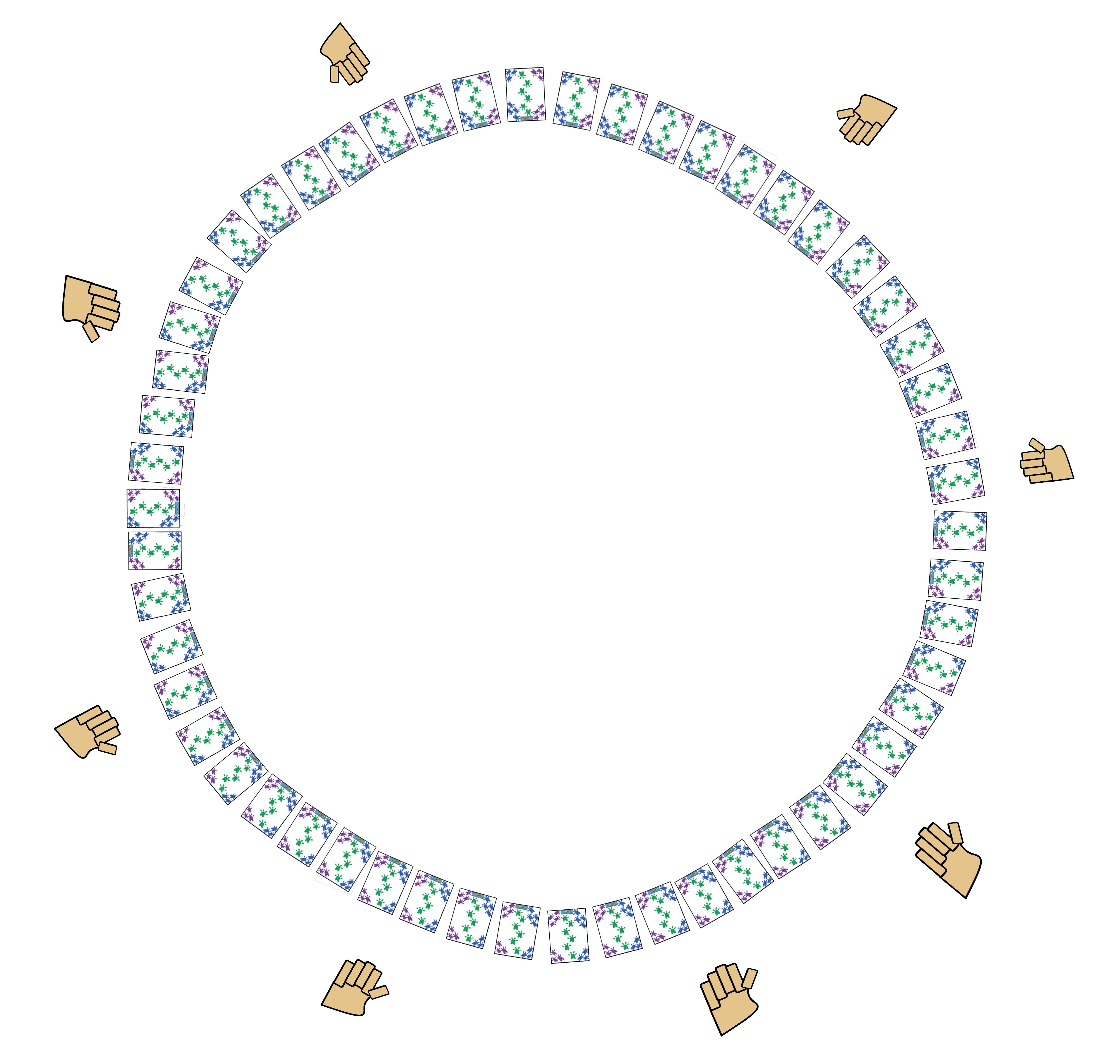 Buta No Shippo
Buta No Shippo: Buta No Shippo is a Japanese game which translates to "Pig's Tail" in English. The game gets it's name from the layout that is created to start the game which resembles a circular pig's tail.
The deck should be thoroughly shuffled by any player and then placed face-down. A large, circular layout is then created on the table with the cards. The player's should all then sit around the circle of cards. The game is designed for 3 to 10 players and uses one standard 52 card deck with two Jokers added.
In order to determine the first player to have a turn, the players may use a number of methods, with an common method for players to play rock, paper scissors (called Janken in Japanese), with the winner of this having the first turn. For those unfamiliar with Janken or Rock-Paper-Scissors, please see this
link for a brief description of how it is played and sometimes used to determine the player to have the first play in a game.
Before taking each turn, all player's should place one hand palm down on the table in front of themselves and outside the circle. The player whose turn it is then, using that same hand, takes any of the face down cards from the circle and flips it face-up in the center of the circle. He then places his hand back down on the table, outside the circle of cards. If the card played fulfills any of the following criteria, the player's attempt to slap this card.
- Any Joker
- A card of the exact same denomination as the last card played.
- A card of the exact same suit as the last card played.
The last player to slap the pile must take all previously played face-up cards in the center of the table, placing them in a neat, face-down pile in front of himself. If a player slaps a card which does not qualify for a slap, he must also take all the cards currently on the table into his pile. A card which qualifies as a slappable card is called an Attack Card and, similarly, a slap is called an Attack.
As the game continues, the face-down cards comprising the circle can be slid inward to make the circle smaller in comparison to the number of cards remaining in the circle.
When the last card from the circle has been played, the player who took the
largest total number of cards is considered the loser of the game and the player who took the least number of cards is declared the winner of the game.
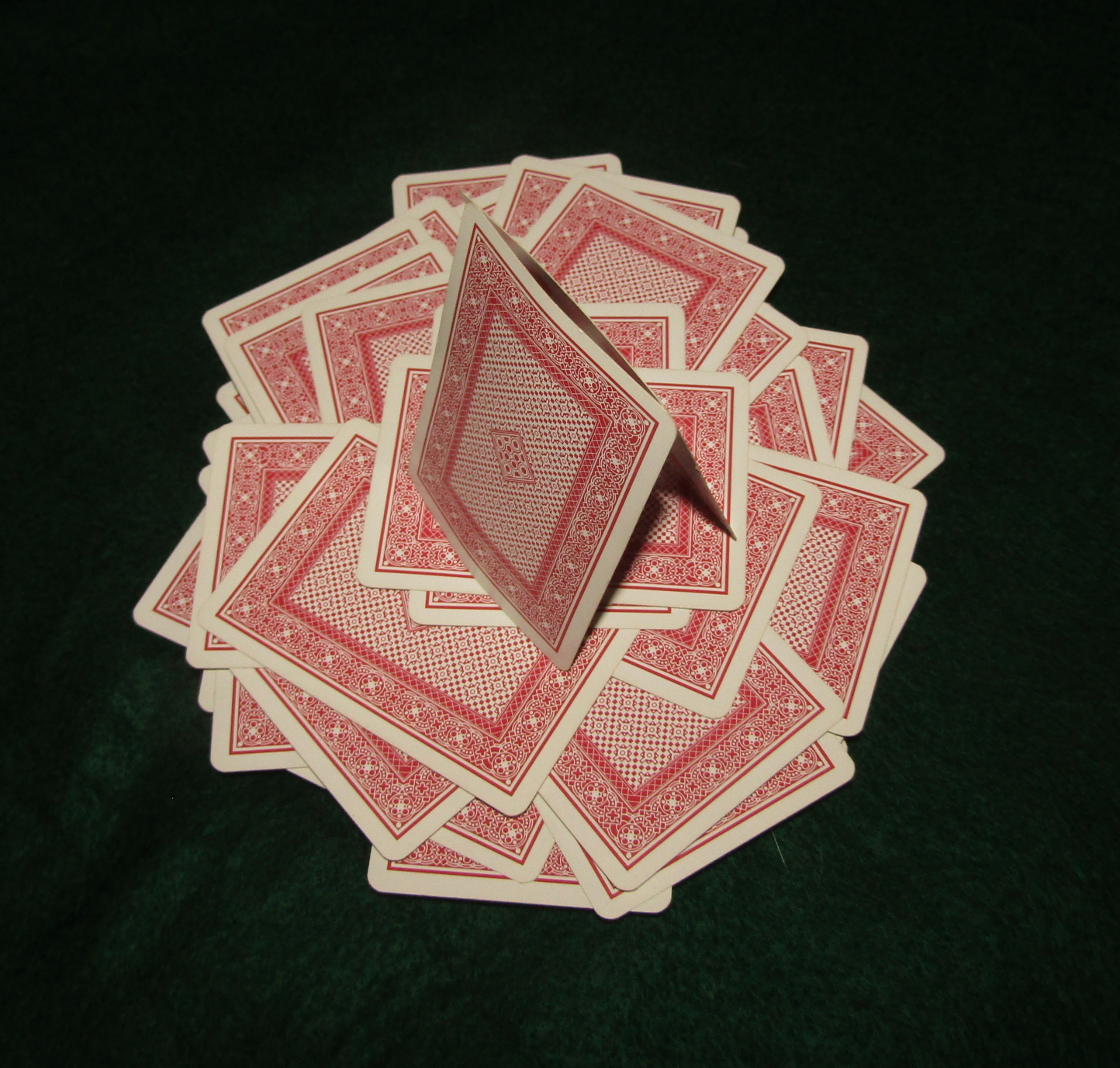 Magarac
Magarac: Magarac (Croatian for "Donkey") is a very unusual Bosnian card game, usually played by children. The game can be played by almost any number (great for 3 to 5) and uses one standard 52 card deck. However, the ranking of the cards as used in the deck as well as the suits are
irrelevant and not used. There is no real
actual dealer either, however it should be determined before play which player will have the first turn. On subsequent games, each player around the table in a clockwise direction should have the opportunity to be this first player an equal number of times. The name of this game is also sometimes given to several other unrelated children's games.
The entire deck should then be formed into a large disarrayed pile
or stack of cards. This pile can (and should) be somewhat chaotic, but all the cards should be contained at least partially in this pile. The top two cards from the pile are then formed, on the top of the remaining pile, in a reverse V shaped structure. The cards should be balanced directly on the center of the top of the pile, and should be made as sturdy as is possible. The forming of the pile and this structure can be an effort shared by all the participants.
After the pile and structure have been formed, the game begins. Each player, starting with the player selected to be the first player for the game, and continuing in a clockwise direction
around the table attempts, using one hand and some finesse, to slide or otherwise remove one card from the pile without causing the inverted V structure to collapse.
He must remove only one card from the pile on each turn and try to have as little impact on any other cards as possible. If the player manages to thus remove a card, with the inverted V structure remaining intact, he retains the card he was able to pull and the turn then rotates to the next player in a clockwise rotation. However, if any player causes the structure to thus collapse (either during his attempt on his turn to remove a card or any other time intentionally or unintentionally) the game immediately ends and that player is considered to be the loser of the game.
Copyright © 2015 CatsAtCards.com. All rights reserved.
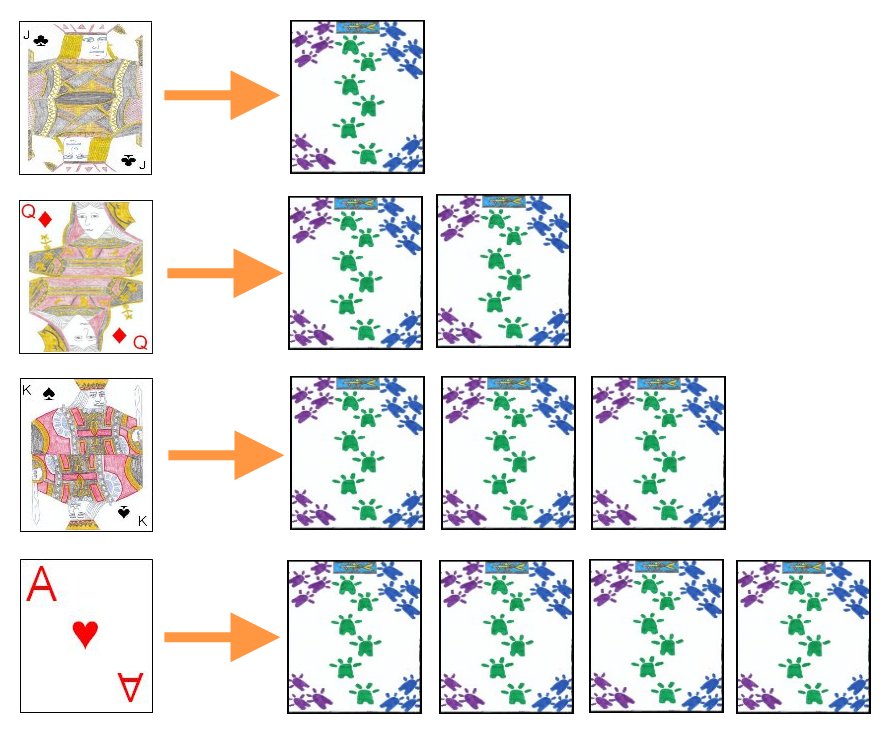
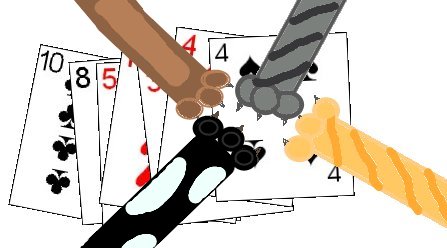


 This version uses one standard deck with the same ranking as the standard game. However in this variant, each card is also provided a specific equivalent numeric value. The following chart shows the values of the cards in the deck used for this game:
This version uses one standard deck with the same ranking as the standard game. However in this variant, each card is also provided a specific equivalent numeric value. The following chart shows the values of the cards in the deck used for this game:



 As each player plays his card on his turn he must clearly state the next card in an ascending series, starting with Ace. Thus, the normal sequence is as follows: Ace, Two, Three, Four, Five, Six, Seven, Eight, Nine, Ten, Jack, Queen, King. The player after the player stating "King" would then start again with Ace, cycling through the series continuously until a valid slappable combination appears. Thus, the first player would state "Ace", the second player "Two", the third player "Three" and so on.
As each player plays his card on his turn he must clearly state the next card in an ascending series, starting with Ace. Thus, the normal sequence is as follows: Ace, Two, Three, Four, Five, Six, Seven, Eight, Nine, Ten, Jack, Queen, King. The player after the player stating "King" would then start again with Ace, cycling through the series continuously until a valid slappable combination appears. Thus, the first player would state "Ace", the second player "Two", the third player "Three" and so on.
